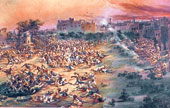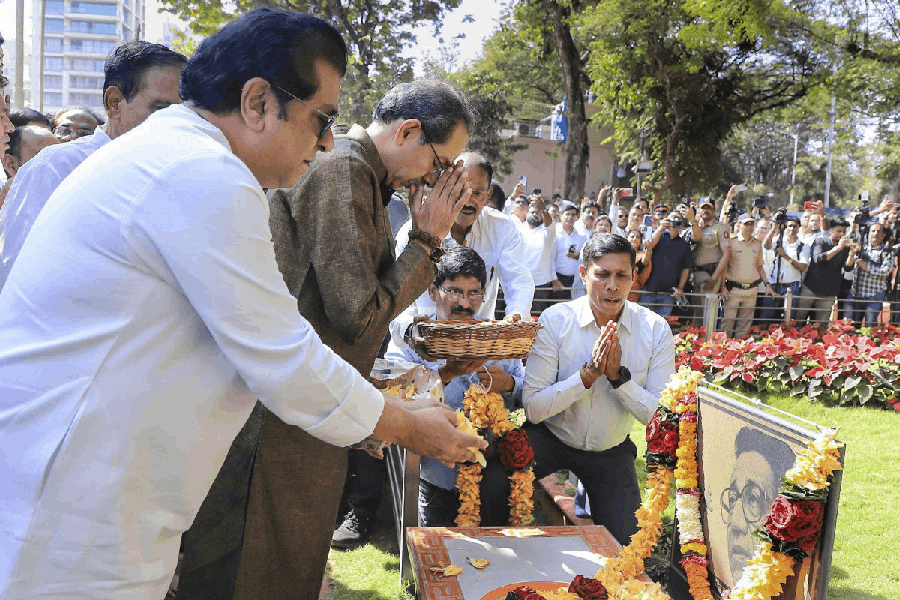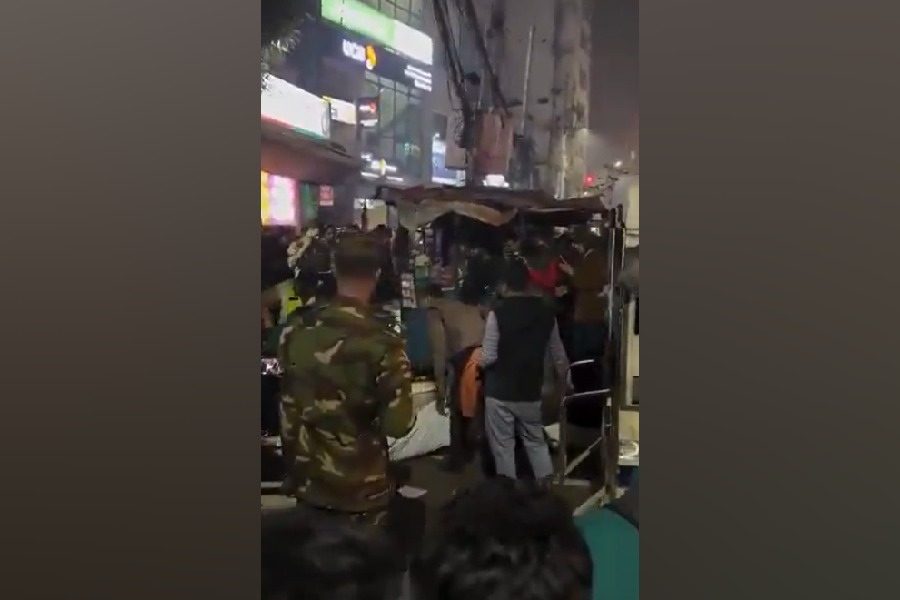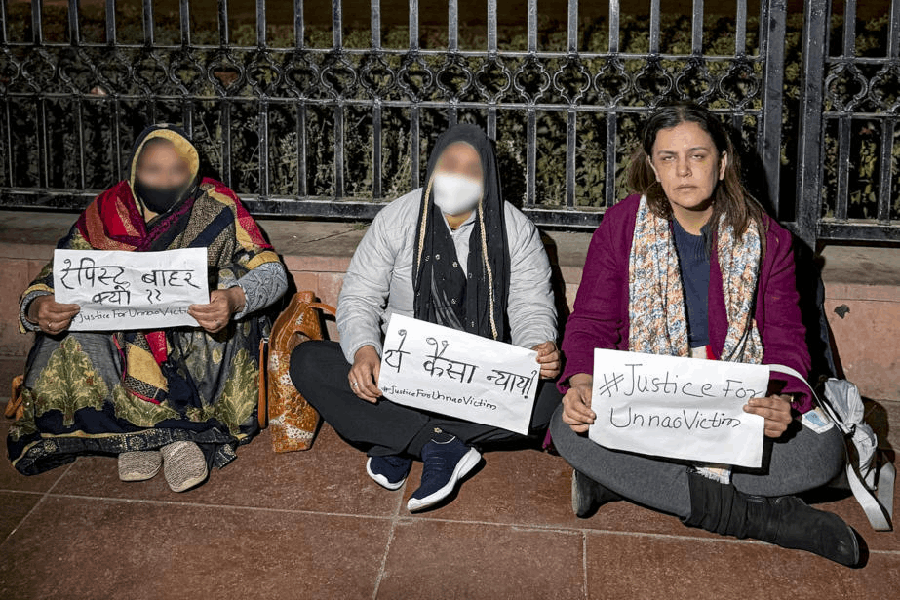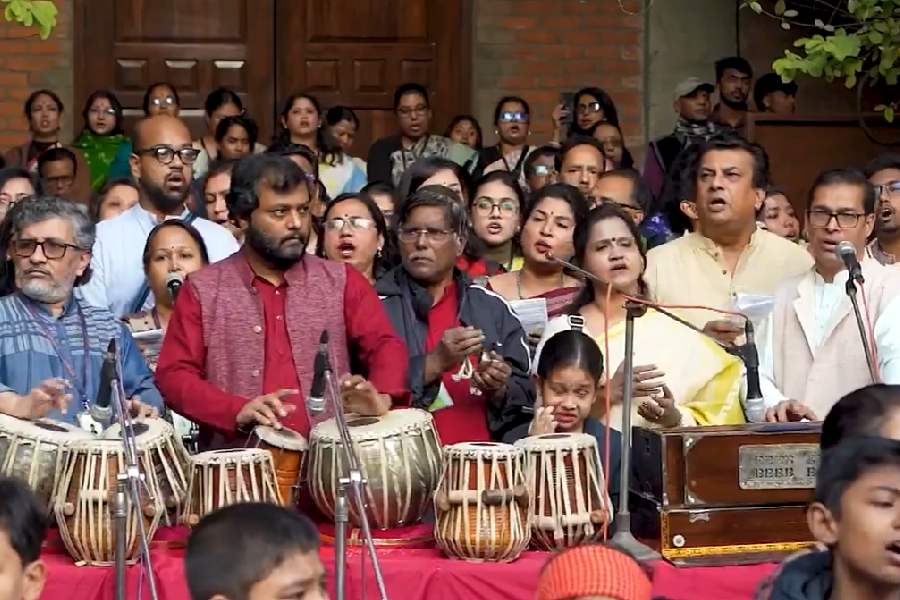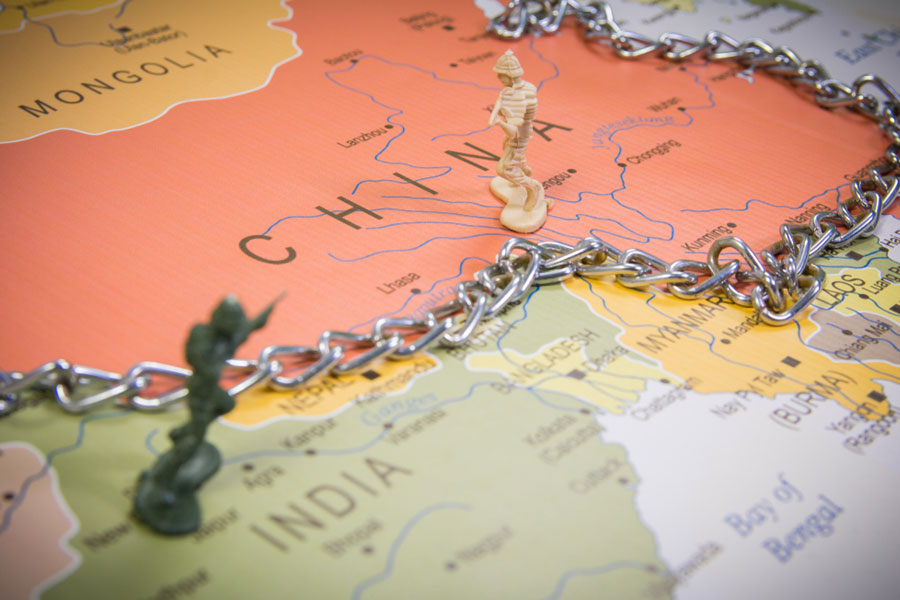 |
| KILLING FIELDS: An artist’s depiction of the massacre in Amritsar; cover of the book (below) Nigel Collett the biographer |
 |
Nigel Collett, the author whose new biography of Brigadier-General Reginald Dyer, The Butcher of Amritsar (Hambledon; ?25), is perhaps the most significant book on Indo-British relations for a generation, puts it very simply.
“As an Englishman, I cannot help but feel sorrow and shame at what he did, and sadness at the huge gap that he created between ourselves and India,” says Collett, himself a former British army officer who served in many of the places that Dyer did. “His crime horrifies me even now.”
On Dyer’s orders on April 13, 1919, hundreds of unarmed men, women and children were shot dead and well over a thousand injured in Jallianwala Bagh in Amritsar. Dyer never once expressed regret in public for his crime but the atrocity sealed the fate of the Raj and hastened Independence.
“As to how many died, I accept the final figure of the Sewa Samiti of 480 known named deaths, but suspect there were many not known,” says Collett. “I would not be surprised if the total deaths had been double that. The 397 accepted by the Hunter Committee (which investigated Dyer’s conduct) was wrong. As to injured, there is no way of knowing accurately. Over 1,000 easily.”
He adds: “Of those who died, most were Muslim or Hindu. Of the 291 whose jats can be identified, only 22 are certainly Sikh.”
Collett appreciates he is entering controversial territory when he asserts: “It would be unpopular to say so, but the Rowlatt agitation that led to the Punjab disturbances was not a Sikh affair to any great degree, mostly a Muslim or Hindu-led and supported one.”
According to Collett, “what Dyer did is politically relevant today; Attenborough’s film, Gandhi, made plain its importance to Gandhi’s Independence struggle. I myself see no difference between what Dyer did and any other political mass murder. In Dyer’s day, this was what the British accused the Germans of in Flanders after the First World War.”
In 1997, on the 50th anniversary of Indian Independence, Queen Elizabeth visited the Golden Temple and although she felt unable to tender a formal apology on behalf of her nation ? the Duke of Edinburgh even queried the casualty figures ? Amritsar remains a stain on the conscience of the British to this day.
“The massacre was the worst atrocity by a British officer ever recorded, and it changed the course of the empire and history,” remarks Collett. “It is the darkness at the heart of the Raj.”
Although he paints the portrait of a “monster”, Collett has avoided a one-dimensional cardboard cut-out for he has also sketched in Dyer’s good side ? and there was a good side.
“He loved his wife, Annie, and his children and looked after them well,” the author points out. “He treated his sons far better than his parents treated him.”
Another crucial element is that “he was not racially prejudiced; his prejudices were anti-civilian. Basically, the army was recruiting Indian officers for the first time. They were of the same status, in army view, as British officers. But the clubs took a different view. He resigned from the Jullundur Club when it refused to admit Indian officers.”
Dyer spoke Hindustani (from childhood, then for army exams), Punjabi (for his Sikh soldiers in 29th & 25th Punjabis), some Pushtu (for his Pathans in 25th Punjabis), some Persian (learned in Peshawar for army exams), tiny amounts of Baluchi (picked up in Baluchistan). “He was personally interested in his men, of whatever race. He enjoyed their company, liked talking to them directly in his tent and bungalow, recommended many of them for bravery and service awards and defended them against civilians. He took great interest in getting them better rations, finding them good billets, requisitioned fans and bicycles for them (all taken from civilians), whether they were British soldiers or Indian. They loved him in return. He was physically a very brave man, renowned for his courage.”
Collett seems ideally placed to solve the mystery behind Dyer. Now aged 52, Collett read history at St Peter’s College, Oxford, before training at Sandhurst and joining the British army. Later, he was a company commander with the Sultan of Oman’s Land Forces, before being loaned to the Zimbabwe army in Harare. He rose to be a lieutenant colonel and commanding officer 6th Gurkhas in Hong Kong from 1991 and was garrison commander in Brunei from 1992-3.
He left the army in 1994 and established Gurkha International Manpower Services Ltd, a company dedicated to finding employment for ex-British army Gurkha soldiers and Nepalese men and women, principally with shipping companies. He also found time to take an MA in biography at the University of Buckingham in 2002. Early in his career he published a book on Baluchi grammar and vocabulary, then one on a course on Baluchi, including the nastaliq script, and finally co-authored a Nepali-English-Nepali dictionary.
He recalls that when he was in Oman, he “collected any book I could find on Baluchistan, and in 1983 found a copy of Dyer’s Raiders of the Sarhad, his account of his campaign in east Persia, in Baluchistan and Sistan. This led me to buy a copy of Ian Colvin’s Life of General Dyer, which was published in 1929. Both sat on my bookshelf until 2001.”
Collett suddenly realised that he had “a similarity of experience, in career terms, with Dyer’s”. “I thought I could understand, at least, what he had done, if not why he had done it. There was also a riddle at the heart of his massacre in Jallianwala Bagh. Such a ghastly and cathartic deed needed laying bare. It was a detective story that had not yet been solved.”
His research took him to the National Archives in Delhi, Shimla, Amritsar and the Golden Temple, the India Office Library in London, as well as to Cambridge, Leeds, Edinburgh, to Ashton Keynes, the farm he bought in Wiltshire, and to Long Ashton, Bristol, where Dyer died, a haunted man, in 1927.
“I found it very hard to get close to Dyer,” confesses Collett. “He was by nature a lonely, reserved man who found it hard to get on with his contemporaries. What he did at Amritsar (and before it in Persia) appalled me. However, he was fascinating where he was least attractive.”
Collett’s answer is: “My interpretation is that Dyer did what he did to assuage his deep-seated fears that the India that was his whole life, and the safety of his family, were under threat in a new mutiny in Punjab in 1919, and that, in Amritsar, he could stop it. But the explanations he gave later for his actions were confusing and unconvincing.”
He goes on: “One other issue is Dyer’s own portrayal of his character, one which has successfully stuck until now ? ‘a tough but honest and simple soldier concerned only with his duty and the truth as he saw it’. This was not the case; the records in Persia and Amritsar reveal a man capable of deception, out for his own advancement, frightened of revealing what he had done to his superiors, and, at times, one who blamed his inferiors for his own mistakes. He deliberately covered up the shooting at the Jallianwala Bagh through fear of the consequences for some six months.”
To many, though Dyer was forced out of the army, he remained a hero. “Dyer was not treated as a rotten apple by the majority of the army, or by the British in general. He was not marginalised in Britain. After his disgrace, he was lionised in England and in India by the British there. That spoiled the next 30 years and made the separation of Britain and India a dishonourable and sad one.”
Collett continues: “Whilst I found nothing much good to say about the members of the imperial hierarchy in India or Britain who dealt with Dyer or about the system itself (I came in the course of writing this book to feel contempt for most of the characters involved and the system they operated), I still conclude that Dyer holds responsibility for what he did. I think he died thinking that, too.”
Collett is convinced that the Amritsar massacre preyed on Dyer’s mind from the very day he opened fire. “He spent the rest of his life trying to justify himself. He persuaded himself it had been his duty to act as he did, but he could not persuade his soul that he had done right. It rotted his mind and, I am guessing here, added to his sickness.”
Something fundamental has changed in the British psyche since Amritsar, observes Collett.
“The British no longer feel it their God-decreed duty to civilise the world,” he says.
A stranger to the English
Book extracts
 |
![]() The man who perpetrated this disaster was made a hero by his British supporters, who idolised him as the ‘Saviour of India’. To almost all Indians, then and now, Dyer was a monster. Yet this was a man, born in India, who was more of a stranger to the English than he ever was to the Indians amongst whom he lived almost all his life. He was a man upon whom was conferred the unheard of honour of being made a Sikh in the Golden Temple in Amritsar. He was an officer revered, even loved, by his Indian troops.
The man who perpetrated this disaster was made a hero by his British supporters, who idolised him as the ‘Saviour of India’. To almost all Indians, then and now, Dyer was a monster. Yet this was a man, born in India, who was more of a stranger to the English than he ever was to the Indians amongst whom he lived almost all his life. He was a man upon whom was conferred the unheard of honour of being made a Sikh in the Golden Temple in Amritsar. He was an officer revered, even loved, by his Indian troops.
![]() The firing continued between ten and fifteen minutes. The noise in the Bagh was a cacophony of rifle crack, bullets thumping into flesh and walls, ricochets screeching off the brickwork, the screams of 25,000 people in terror and the cries of the wounded.
The firing continued between ten and fifteen minutes. The noise in the Bagh was a cacophony of rifle crack, bullets thumping into flesh and walls, ricochets screeching off the brickwork, the screams of 25,000 people in terror and the cries of the wounded.
![]() Dyer was later to explain that his action at the Jallianwala Bagh stopped the spread of insurrection in the Punjab.
Dyer was later to explain that his action at the Jallianwala Bagh stopped the spread of insurrection in the Punjab.
![]() Once, a white-haired old lady, carried a wreath with a card, which read: “To the great, gallant, splendid, noble soldier, General Dyer, from a Major’s daughter”.
Once, a white-haired old lady, carried a wreath with a card, which read: “To the great, gallant, splendid, noble soldier, General Dyer, from a Major’s daughter”.
![]() In India, the British Indian press continued its self-defeating campaign of rubbing salt in Indian wounds. The Civil and Military Gazette had a front page devoted to Dyer and quoted Sir Michael O’Dwyer’s words: “General Dyer was the last man in the world to use force recklessly or until it was absolutely necessary.”
In India, the British Indian press continued its self-defeating campaign of rubbing salt in Indian wounds. The Civil and Military Gazette had a front page devoted to Dyer and quoted Sir Michael O’Dwyer’s words: “General Dyer was the last man in the world to use force recklessly or until it was absolutely necessary.”
![]() It was his misfortune that, on that April evening in Amritsar, he unleashed the forces that were to destroy the India he had spent his life trying to preserve.
It was his misfortune that, on that April evening in Amritsar, he unleashed the forces that were to destroy the India he had spent his life trying to preserve.

